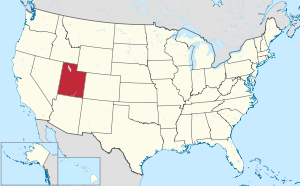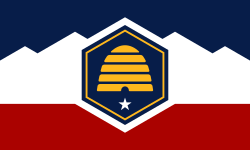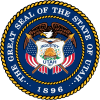
Back Utah Afrikaans ዩታህ Amharic Utah AN Ūta ANG يوتا Arabic ܝܘܬܐ ARC يوتا ARY يوتا ARZ Utah AST Utah suyu Aymara
Utah | |
|---|---|
| Nicknames: "Beehive State" (official), "The Mormon State", "Deseret" | |
| Motto: Industry | |
| Anthem: "Utah...This Is the Place" | |
 Location of Utah within the United States | |
| Country | United States |
| Before statehood | Utah Territory |
| Admitted to the Union | January 4, 1896 (45th) |
| Capital (and largest city) | Salt Lake City |
| Largest county or equivalent | Salt Lake |
| Largest metro and urban areas | Salt Lake City |
| Government | |
| • Governor | Spencer Cox (R) |
| • Lieutenant Governor | Deidre Henderson (R) |
| Legislature | State Legislature |
| • Upper house | State Senate |
| • Lower house | House of Representatives |
| Judiciary | Utah Supreme Court |
| U.S. senators | Mike Lee (R) John Curtis (R) |
| U.S. House delegation | 1: Blake Moore (R) 2: Celeste Maloy (R) 3: Mike Kennedy (R) 4: Burgess Owens (R) (list) |
| Area | |
• Total | 84,899 sq mi (219,887 km2) |
| • Land | 82,144 sq mi (212,761 km2) |
| • Water | 2,755 sq mi (7,136 km2) 3.25% |
| • Rank | 13th |
| Dimensions | |
| • Length | 350 mi (560 km) |
| • Width | 270 mi (435 km) |
| Elevation | 6,100 ft (1,860 m) |
| Highest elevation | 13,534 ft (4,120.3 m) |
| Lowest elevation | 2,180 ft (664.4 m) |
| Population (2024) | |
• Total | |
| • Rank | 30th |
| • Density | 36.53/sq mi (14.12/km2) |
| • Rank | 41st |
| • Median household income | $93,400 (2023)[5] |
| • Income rank | 8th |
| Demonym | Utahn[6][b] |
| Language | |
| • Official language | English |
| Time zone | UTC−07:00 (Mountain) |
| • Summer (DST) | UTC−06:00 (MDT) |
| USPS abbreviation | UT |
| ISO 3166 code | US-UT |
| Traditional abbreviation | Ut. |
| Latitude | 37° N to 42° N |
| Longitude | 109°3′ W to 114°3′ W |
| Website | utah |
| List of state symbols | |
|---|---|
 | |
 | |
 | |
| Emblem | Beehive[8] |
| Living insignia | |
| Bird | California gull |
| Fish | Bonneville cutthroat trout[9] |
| Flower | Sego lily |
| Grass | Indian ricegrass |
| Insect | Western honey bee |
| Mammal | Rocky Mountain elk |
| Reptile | Gila monster |
| Tree | Quaking aspen |
| Inanimate insignia | |
| Dance | Square dance |
| Dinosaur | Utahraptor |
| Firearm | Browning M1911 |
| Fossil | Allosaurus |
| Gemstone | Topaz |
| Mineral | Copper[9] |
| Rock | Coal[9] |
| Tartan | Utah State Centennial Tartan |
| State route marker | |
 | |
| State quarter | |
 Released in 2007 | |
| Lists of United States state symbols | |
Utah[c] is a landlocked state in the Mountain West subregion of the Western United States. It is one of the Four Corners states, sharing a border with Arizona, Colorado, and New Mexico. It also borders Wyoming to the northeast, Idaho to the north, and Nevada to the west. In comparison to all the U.S. states and territories, Utah, with a population of just over three million, is the 13th largest by area, the 30th most populous, and the 11th least densely populated. Urban development is mostly concentrated in two regions: the Wasatch Front in the north-central part of the state, which includes the state capital, Salt Lake City, and is home to roughly two-thirds of the population; and Washington County in the southwest, which has approximately 180,000 residents.[10] Most of the western half of Utah lies in the Great Basin.
Utah has been inhabited for thousands of years by various indigenous groups, such as the ancient Puebloans, the Navajo, and the Ute. The first Europeans to arrive – in the mid-16th century – were the Spanish. Because of the region's challenging geography and harsh climate, it only became a peripheral part of New Spain (and later of Mexico). Even while it was Mexican territory, many of the Utah region's earliest European settlers were from the United States; notable among these were Mormons who were fleeing marginalization and persecution in the United States and arrived via the so-called Mormon Trail. In 1848, after the Mexican–American War, the region was annexed by the U.S., becoming part of the Utah Territory, which included what later became Colorado and Nevada. Disputes between the dominant Mormon community and the federal government delayed Utah's admission as a state: in 1896, after it agreed to outlaw polygamy, it was admitted as the 45th state.
People from Utah are known as Utahns.[6], published 5 March 2025, accessed 6 March 2025</ref> Slightly over half of all Utahns are Mormons, the vast majority of whom are members of the Church of Jesus Christ of Latter-day Saints (LDS Church), which has its world headquarters in Salt Lake City;[11] Utah is the only state where a majority of the population belongs to a single church.[12] The LDS Church greatly influences Utahn culture, politics, and daily life,[13] though since the 1990s the state has become more religiously diverse as well as secular.
Utah has a highly diversified economy, with major sectors including transportation, education, information technology and research, government services, mining, multi-level marketing, and tourism.[14] Utah has been one of the fastest growing states since 2000,[15] with the 2020 U.S. census confirming the fastest population growth in the nation since 2010. St. George was the fastest-growing metropolitan area in the United States from 2000 to 2005.[16] Utah ranks among the overall best states in metrics such as healthcare, governance, education, and infrastructure.[17] It has the 12th-highest median average income and the least income inequality of any U.S. state. Over time and influenced by climate change, droughts in Utah have been increasing in frequency and severity,[18] putting a further strain on Utah's water security and impacting the state's economy.[19]
- ^ "Kings Peak Target". NGS Data Sheet. National Geodetic Survey, National Oceanic and Atmospheric Administration, United States Department of Commerce. Retrieved October 24, 2011.
- ^ a b "Elevations and Distances in the United States". United States Geological Survey. 2001. Archived from the original on November 9, 2013. Retrieved October 24, 2011.
- ^ Arave, Lynn (August 31, 2006). "Utah's basement—Beaver Dam Wash is state's lowest elevation". Deseret Morning News. Archived from the original on January 22, 2015.
- ^ "United States Census Quick Facts Utah". Retrieved January 9, 2025.
- ^ "Household Income in States and Metropolitan Areas: 2023" (PDF). Retrieved January 12, 2025.
- ^ a b "Utah's legislative session: We're officially Utahns now". Deseret News. March 5, 2025. Retrieved March 7, 2025.
- ^ "Utah", Merriam-Webster.com (Online Dictionary ed.), Merriam-Webster, archived from the original on November 4, 2014
- ^ Utah Code, Title 63G, Chapter 1, Part 6, Section 601(10)
- ^ a b c "Utah State Facts and Symbols". Utah.com. Archived from the original on April 14, 2021. Retrieved April 26, 2021.
- ^ "Introduction: Urban Growth in Utah", QGET Databook, Quality Growth Efficiency Tools (QGET) Technical Committee, Governor's Office of Management & Budget, State of Utah, 1997, archived from the original on November 4, 2014, retrieved November 4, 2014; see also: "Figures: Population Growth, 1940–2020 (slide 3)", QGET Databook, 1997, archived from the original on November 4, 2014, retrieved November 4, 2014
- ^ "Adults in Utah - Religion in America". Pew Research Center. Retrieved June 28, 2020.
- ^ "American Religious Identification Survey (2001)". ISSSC. Archived from the original on November 3, 2011. Retrieved October 31, 2011.
- ^ Canham, Matt (April 17, 2012). "Census: Share of Utah's Mormon residents holds steady". The Salt Lake Tribune. Archived from the original on November 4, 2014.
- ^ Lindsey, Daryl (September 8, 2016). "Follow the profit: How Mormon culture made Utah a hotbed for multi-level marketers". Retrieved March 28, 2023.
- ^ The Fastest-Growing States in America (and Why They're Booming)—Jordan Weissmann Archived May 25, 2017, at the Wayback Machine. The Atlantic (December 22, 2012). Retrieved on July 12, 2013.
- ^ "Appendix E.—Ranking Tables" (PDF). State and Metropolitan Area Data Book: 2006. U.S. Census Bureau. December 22, 2008. Archived (PDF) from the original on March 25, 2009. Retrieved April 29, 2009.
- ^ "Best States Rankings". U.S. News & World Report. 2021.
- ^ Amy Joi O'Donoghue (February 14, 2022). "How bad is the Western drought? New study says worst in 1,200 years. You read that right". Deseret News. Retrieved February 18, 2022.
- ^ "If we want growth, we need water solutions". www.utahbusiness.com. May 11, 2022. Retrieved July 13, 2022.[title missing]
Cite error: There are <ref group=lower-alpha> tags or {{efn}} templates on this page, but the references will not show without a {{reflist|group=lower-alpha}} template or {{notelist}} template (see the help page).

